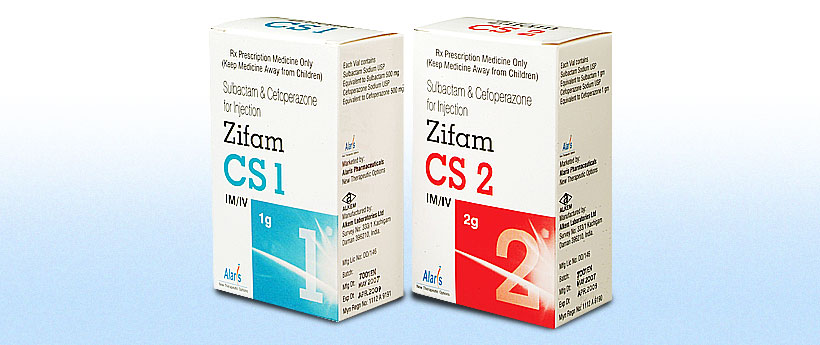ZIFAM CS1 / CS2
- ENG
- မြန်မာ

Cefoperazone and Sulbactam for injection
Composition
Each vial contains:
Sterile Cefoperazone Sodium USP
equivalent to Anhydrous Cefoperazone 500mg/ 1000mg
Sterile Sulbactam Sodium USP
equivalent to Anhydrous Sulbactam 500mg/ 1000mg
Description
The Sulbactam sodium and Cefoperazone sodium combination consists of a betal lactamase inhibitor plus a betal lactam.
This Sulbactamsoidum and Cefoperazone sodium combination is available as dry powder for reconstitution in a 1:1 ratio. Vials contains the equivalent of 500mg + 500mg (1 g vial), 1000mg (2 g vial) of sulbactam and cefoperazone respectively.
Indications
Zifam CS1/CS2 is indicated for the treatment of the following infections when caused by susceptible organisms:
- Respiratory Tract Infections (Upper and Lower)
- Urinary Tract infections(Upper and Lower)
- Peritonitis, Cholecystitis, Cholangitis, and Other Intra- Abdominal Infections
- Septicemia
- Meningtis
- Skin and Soft Tissue Infections
- Bone and Joint Infections
- Pelvic inflammatory Disease, Endometritis, Gonorrhea, and Other Infections of the Genital Tract
Dosage & Administration
| Total dosage(g) | Equivalent dosage of Sulbactam + Cefoperazone (g) | Volume of diluent conc.(ml) | Maximum final dose of Sulbactam + Cefoperazone (mg/ml) |
| 1.0 | 0.5+0.5 | 4.0 | 125+125 |
| 2.0 | 1.0+1.0 | 8.0 | 125+125 |
The usual adult dose of Zifam CS1/CS2 is 2 to 4 g per day (i.e 1 to 2g per day cefoperazone activity, given intravenously or intramuscularly in equally divided dose every 12 hours. In severe or refractory infections the daily dosage of Zifam CS1/CS2 may be increased up to 8 g of the 1:1 ratio may require additional cefoperazone administered separately. Doses should be administered every 12 hours in equally dosage of sulbactam is 4g.
The usual dosage of Zifam CS1/CS2 in children is 40 to 80mg/kg/day (i.e. 20-40 mg/kg/day cefoperazone activity) in 2 to 4 equally divided doses. In severe or refractory infections the daily dosage of Zifam CS1/CS2 may be increased up to 160mg/kg/day of the 1:1 ratio (i.e., 80 mg/kg/day cefoperazone activity) in 2 to 4 equally divided doses.
For neonates in the first week of life, the drug should be given every 12 hours. The maximum daily dosage of sulbactam in pediatrics should not exceed 80 mg/kg/day. If more than 80mg/kg/day of Cefoperazone activity are necessary, additional Cefoperazone should be administered.
Intravenous Administration: For intermitted infusion each vial of Zifam CS1/CS2 should be reconstituted with the appropriate amount of 5% dextrose in Water, 0.9% Sodium chloride injection or Water for injection and then diluted to 20ml with the same solution followed by administration over 15 to 60 minutes.
Intramuscular Administration: Water for injection should be used for reconstitution. For a concentration of cefoperazone of 250 mg/ml or larger, a two step dilution is required using water for injection followed by 2% lidocaine to approximate a 0.5% lidocaine solution. LidocaineHCL 2 % is a suitable vehicle for intramuscular administration; however, it is not for initial reconstitution.
Adverse Effects
Zifam CS1/CS2 is generally well tolerated. Adverse reactions are mild and transient. The common side effects reported are gastro-intestinal disturbances, hypersensitivity reactions including skin rashes, urticaria, pruritus, interstitial nephritis, drug fever and very rarely anaphylaxis.
Drug interactions
Zifam CS1/CS2 has been shown to be compatible with Water for injection, 5% dextrose, 0.9% Sodium chloride. Initial reconstitution with Lactated Ringer’s Solution or with 2% lidocaine HCI solution should be avoided since these mixtures has been shown to be incompatible.
Overdosage
Limited information is available on the acute toxicity of cefoperazone sodium and sulbactam sodium in humans. Overdosage of the drug would be expected to produce manifestations that are principally extensions of the adverse reactions reported with the drug.
Presentation
Box containing 1g/2g Zifam CS1/CS2 injection vial with water for injection and Packaging insert.





